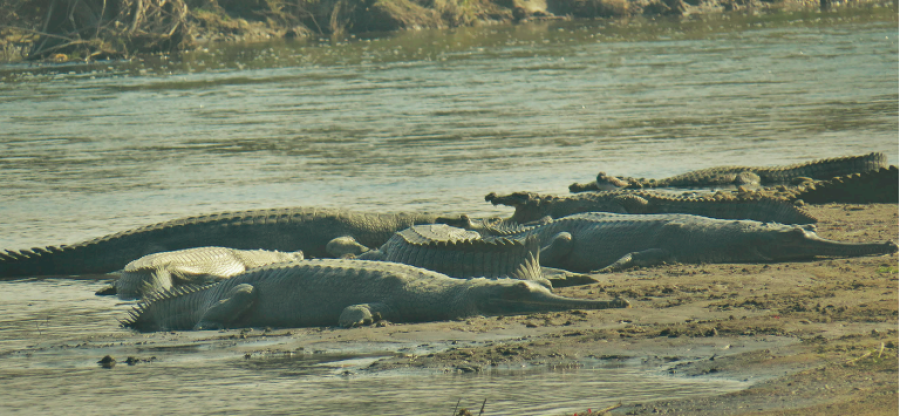National
Conservationists see glimmer of hope with increasing number of gharials in Rapti river
The total gharial population in their natural habitats across the country stands at 230.
Ramesh Kumar Paudel
The Rapti river, which passes through Chitwan National Park, is gradually turning into a major natural habitat of gharials—a critically endangered crocodile species, say conservationists.
According to Bed Khadka, assistant conservation officer at the national park, the river has become home to more than 100 gharials in the last three decades.
“The number started increasing in recent years,” said Khadka, who is also the chief of the national park’s gharial breeding centre. “Not a single gharial was found in the Rapti river three decades ago but now the river is home to many.”
Gharial conservation is challenging, as the species’ survival rate in the natural habitat is very low.
“A gharial lays 30 to 50 eggs a year. Even after successful hatching, only one to five percent of the hatchlings survive,” said Baburam Lamichhane, chief at the Sauraha Office of National Trust for Nature Conservation. “So the increase in gharial population in the last few years is noteworthy.”
According to Lamichhane, the total gharial population in their natural habitats across the country stands at 230.
“The Rapti river has the highest number with 118 gharials at present. There are 101 gharials in the Narayani river while the remaining are found in the Karnali and Babai rivers,” he said.
Lamichhane said a study conducted in 1989 had shown that there were only 50 gharials in their natural habitats in Chitwan district but none in the Rapti river.
“But now, gharials have been spotted from Lothar in the east to Gholaghat in the west in the Rapti river,” he said.
The national park in 1978 established a gharial breeding centre in Kasara with an objective to conserve the crocodile species by hatching its eggs and releasing them in the rivers when they grow up to two metres in length. According to Lamichhane, a total of 1,246 baby gharials were released in various rivers and rivulets until 2018.
As many as 566 gharials have been released in Rapti, 399 in Narayani, 110 in Babai, 95 in Koshi, 41 in Karnali and 35 in Kaligandaki so far. According to conservationists, gharials released in Koshi and Kaligandaki rivers haven’t been spotted yet.
Most conservationists and conservation agencies believe that some rivers might not be suitable hosts to gharials and hence some released baby gharials do not survive infancy. Out of all the rivers, Rapti has proven to have the most favourable environment for gharials. Conservationists, therefore, have decided to release more gharials into the river.
“The gharials in the breeding centre are grown in a relatively narrow space. They are conditioned to thrive in smaller rivers like Rapti. It is a cold-blooded animal and survives well in warm water. Since the water in Rapti is warmer than in Narayani, the survival rate of baby gharials released in Rapti is high,” said Khadka.
Gharials, a critically endangered crocodile species, are found in some rivers of Nepal, India and Bangladesh, according to Lamichhane, who is also a researcher on gharials.
The gharial population, which was estimated to be between 5,000 and 10,000 worldwide during the 1940s, declined by almost 96 percent to below 200 by 1976. This species—the only surviving member of the Gavialidae family—breeds only in the wild of Nepal and India and occupies only two percent (less than 200 mature breeding adults in number) of its historical range at present. The gharials have already gone extinct from Myanmar, Pakistan and Bhutan.
In Nepal, the gharial has been enlisted as a protected species. Conservationists say amid multiple challenges in gharial conservation, a threat to their habitats is the most worrisome. Gharial habitats are under threat due to human activities, river pollution and depletion in fish numbers.
“The depletion in fish numbers due to overfishing and use of fishing nets that trap gharials are the leading challenges in gharial conservation,” said Ananath Baral, the chief conservation officer at Chitwan National Park. According to him, gharials live in fresh and clean water and mainly prey on fish.
The use of fishing nets that trap gharials along with fish is unlawful in rivers that are home to endangered species. The national park authority allows fishermen from the Bote community to use hand-fishing nets but has banned the installation and use of big nets in water bodies. According to Khadka, around 12 gharials get trapped in such fishing nets and die in the Rapti and Narayani rivers every year.
The national park imposed a ban on fish items at the park in a desperate bid to shore up gharial population in March, 2018. According to conservationists, the decision was taken to cut down on the consumption of fish—the main food for gharials. As per this decision, fish is not cooked in the national park’s kitchen and in the army camps in the park area. The park administration also claimed to have a strict policy in issuing fishing licenses.
“Fishing licenses have been issued to around 200 people now. As many as 1,000 people had fishing licenses a few years ago,” said Baral.
Gharials are also swept away by river currents and this makes their conservation all the more challenging. Some gharials, according to Khadka, released in the Rapti river in March were found in the Hoogli river of West Bengal, India, in May. The gharials were found around 1,100 km from where they were released.
Bishnu Thapa, a Sauraha-based tourist guide, said he had spotted many gharials in the Dudhaura area of the Rapti river in July.
“I had counted 126 gharials then. I went to the same area in August second week but I could not see a single gharial,” said Thapa.
Conservationists say that many gharials in the area were swept by floods triggered by monsoon rain.
“It is very difficult to conserve gharials. They get easily swept up by rives. The efforts of the government authorities and technicians are not enough. The local community should also work hand in hand with the government agencies for gharial conservation,” said Ramprit Yadav, a conservationist.




 17.12°C Kathmandu
17.12°C Kathmandu1.jpg)













%20(1).jpg&w=300&height=200)

